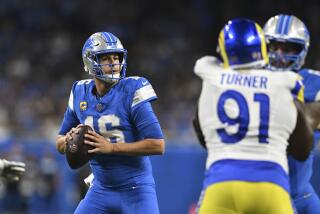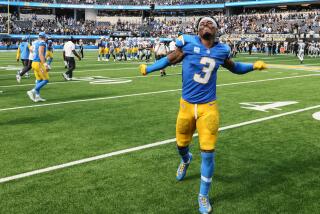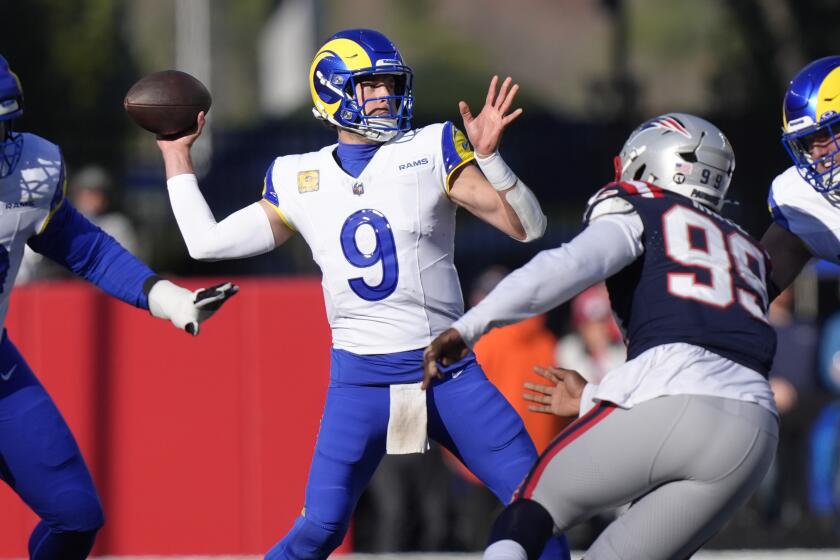Surprising Showdowns
Astonishing everyone who has been asleep for a month, the NFL’s two big games Sunday will involve three of the four teams from the AFL’s old Western Division that were not considered preseason Super Bowl favorites.
The Game of the Week looks like it could be San Diego (4-0) at Denver (3-1). Or perchance Oakland (3-0) at Buffalo (2-2).
Under new quarterback Drew Bledsoe, the Bills have been gaining new respect this year. This week they will have to contend with the lively Raider air force people, who, again in Week 4, threw the ball twice as often as they ran it. That (plus three special-team or defensive-team touchdowns) overwhelmed Tennessee by a phenomenal margin, 52-25. In Raider quarterback Rich Gannon’s first start after launching 64 passes at Pittsburgh—where he completed an NFL-record 43 to stun the Steelers, 30-17—he completed 29 of 39 in another stunner. Young Jerry Rice, who caught 11 for 94 at Pittsburgh, caught seven for 144 and one of Gannon’s four touchdown passes in the Tennessee game. Gannon’s age is 37, Rice’s 39 going on 40. You can play catch forever.
Are Chargers Neanderthals?
ALL FOUR OF Los Angeles’ favorite pro clubs—the Raiders, Rams, Cowboys and Chargers—were on network television Sunday, when few viewers were surprised that three of them won. More surprising, one winner was San Diego, which upset Super Bowl-champion New England, 21-14. More surprising yet, the Charger way was the opposite of Oakland’s. The Chargers, who lofted only 18 passes all day, ran the ball twice as often as they threw it. Said new Charger Coach Marty Schottenheimer: “I’m going to send San Diego back to the Neanderthal age.” If so, the Chargers will never win a Super Bowl.
Beyond all doubt, an NFL running team can run its way into the playoffs—as, in Schottenheimer’s 16-year pro career, his charges have done 11 times without ever reaching the Super-Bowl plateau. For it’s passing teams that normally win there. The present passing era began with San Francisco’s Bill Walsh in the 1980s, when, as Schottenheimer’s luck would have it, his pro career began. A big future for San Diego depends on new passer Drew Brees, a good one who’s already helped Schottenheimer win this season, and who is having the wonderful luck of breaking in on a running team that can break him in slowly. The question: How soon can Brees take charge?
Nothing Like Long Touchdown Runs
LaDAINIAN TOMLINSON, the San Diego runner whose 27 runs kept the ball away from pass-master New England, had the kind of game that inspires comparisons. His achievement was not so much in his 217 rushing yards. It was in the distance of his two touchdown runs: 37 and 58 yards.
The mere scoring of touchdowns is no big deal in pro football. At Jacksonville, running back Stacey Mack got his name in the papers Monday for scoring three times—on runs of 1, 1, and 8 yards. At Seattle, running back Shaun Alexander scored five touchdowns—four on runs of 2, 20, 3 and 14 yards and the fifth on a screen pass. Pro running backs do that sort of thing all the time.
What they don’t do regularly is parlay long-distance touchdown carries. The most difficult play in football is the long touchdown run from scrimmage, which is also the most interesting play in football. What makes it so entertaining is the teamwork of the many blockers and the artistry of the ballcarriers as they cut and weave along. Big touchdown passes aren’t easy, either, but in a typical fall weekend, there are always more of them than long scoring runs.
Schottenheimer made the parlay of the week when his offensive machine got touchdown runs of 37 and 58 yards in back-to-back quarters as Tomlinson performed brilliantly for the thousands of Eastern viewers who have adopted the Patriots as their own in football—in the same sense that the Yankees are their own in baseball. The Tomlinson day wasn’t up to that of the 1924 day when Red Grange, then of Illinois, beat Michigan on touchdown runs of 95, 67, 45 and 56 yards—all in the first 12 minutes—but it was pretty good.
Carolina Kicker Lets Peete Down
THE PATRIOTS LOST at San Diego in part because there are some injured pieces in Coach Bill Belichick’s finely tuned defense. In part, Adam Vinatieri of the Patriots, who has been kicking on another planet since last year, finally threw a shoe.
By blowing an easy field goal, Vinatieri proved again the validity of what’s been true ever since soccer kickers were allowed into this sport, ending a U.S. precedent that still keeps golfers or bowlers or horseshoe pitchers, for instance, from relief roles as baseball pitchers.
The truth: Rely on any placekicker and he’ll eventually break your heart.
But most of all, perhaps, the Patriots lost because quarterback Tom Brady, like San Diego’s man Brees, is a young and inexperienced passer.
This is Brady’s first full season as an NFL quarterback after a college career on a running team. He’s still learning every day—on virtually every play. No spectator can possibly appreciate the magnitude of what NFL quarterbacks have to learn. Thus none of us can possibly appreciate the difference between Brady, a 25-year-old child as the pros measure time, and Green Bay’s Brett Favre, say, who at 33 has been in the league 12 years and an NFL starter for 10.
On Monday morning, Favre and Brady would both have got up losers if, in a game that Green Bay won from Carolina, 17-14, Carolina kicker Shayne Graham hadn’t broken Panther passer Rodney Peete’s heart, blowing a chip-shot field goal (24 yards) in the last 13 seconds. We’ll never know if Peete could have beaten Favre in overtime, but during the first four quarters at Green Bay he drove the Panthers repeatedly. He’s been doing that all season.
Martin Played Like Warner
A RAM-49ER GAME is after all these years one of the best shows in the West. And conceivably, the tradition will last through Sunday’s renewal at San Francisco, where the Rams will introduce their new starter at quarterback. He is one Jamie Martin, who replaced injured Kurt Warner as the Rams lost again Sunday, blowing the Dallas game, 13-10.
The pertinent question now: If the Rams can’t beat the Cowboys, who can they beat? That’s suddenly up to Martin, and the pertinent comment is: You can’t say the Rams lost this one because they lost Warner.
Against Dallas, Martin played at least as well as Warner has been playing. The Rams’ missing link this season has been the old Ram magic—as personified by Warner when he was throwing all those spectacular passes last year and the year before and the year before that. And against Dallas in the final 2:00 of the half, Martin, ending his seven-play, 63-yard drive, brought back the magic. He struck the Dallas defense with a 31-yard bolt—a hard pass to wide receiver Isaac Bruce on a touchdown play that was as well executed as any in the Rams’ Super Bowl years.
Ram leader Mike Martz has kept Martin around for as long as he’s been coaching in St. Louis while using the eight-year NFL veteran hardly at all. That’s because, at first, Trent Green seemed slightly better than either Warner or Martin, and because, after Green was hurt, Warner seemed slightly better than Martin. But now it’s clearer than ever that the Martz system is what manufactures the Ram magic.
Martz Critics Let Rams Down
THE MARTZ PROBLEM now is that his hometown critics are bashing him every day, every hour around the clock, for mostly the wrong reasons. Their basic faulty analysis—their No. 1 complaint—is that Martz doesn’t call enough runs for running back Marshall Faulk. This complaint, which has been made a million times, more or less, in St. Louis and in the national TV studios, ignores some plain evidence, which bashers everywhere customarily do.
That evidence shows that Faulk is only a picture running back when Ram opponents line up in pass defenses. When they’re in an eight-man front in ground defenses, Faulk is usually as helpless as any other running back. He can hardly move on power plays, as the Rams evidenced against Dallas when they tried to run him on first down or in short yardage. A week or so earlier, Faulk nearly broke his neck on an ill-advised power run.
Martz, though, with the complaints of his many bashers ringing in his ears, has found it prudent to call on Faulk anyway in hopeless running situations. Most seriously, in the Dallas game’s final 2:00 after Martin had moved the Rams into scoring position with typical Martz lightning bolts—passes and one surprise end-around run by Bruce—the coach sent in a power-running play for Faulk on first down. Nothing there. Next, hoping another running play, another end-around, would somehow work in the red zone and tone down the bashers, Martz lived to see that it didn’t. Only on third down did he elect to throw, and then, characteristically, as an NFL front eight played the passer to pass, they sacked him.
Martin showed enough to suggest that if Martz had called for three red-zone passes in a row—and the Rams have several good ones for use down there—they would have had a better chance to score. The Rams will win again only when Martz resumes doing it his way. Requirement No. 1 for football’s greatest active coach is to ignore nearly everything he hears from any source in St. Louis.
Top Deals: Harrington, Hakim
JOEY HARRINGTON, the Detroit Lions’ rookie quarterback, pulled them out of their slump in Week 4 with a respectable performance highlighted by his 38-yard, second-quarter touchdown pass to wide receiver Bill Schroeder, a play that surprisingly put Detroit so far ahead, 20-0, that New Orleans couldn’t catch up in a 26-21 upset.
Harrington’s big pass, one of his 20 completions in 35 tries, was delivered on first down, a throwing situation for all passers, as they keep saying, although it hasn’t been in Detroit’s tradition.
The play was typical of Harrington, smoothly done with his classic throwing motion, and with a classic approach to his job. That is, with Schroeder as the primary receiver, Harrington first looked to his right, throwing off the defensive Saints, and then looked left, where Schroeder was tearing into the end zone.
The most important thing about Detroit’s scoring sequence that time was that, on the preceding play, Harrington had gained 40 yards with a long strike to former Ram wide receiver Az-Zahir Hakim—the fastest Lion as he was the fastest Ram. Thus, Harrington, to score, was passing twice on successive plays. In other years after a big pass, the Lions have typically reasoned that, having proved they could throw, they would now prove they can run. And as a rule, that didn’t happen.
New Detroit CEO Matt Millen, however, made the league’s two best offseason deals—signing Hakim as a free agent and drafting Harrington on the first round—giving the Lion offense much-needed big-play ability.
The only remaining Detroit questions, it could be, are whether the other Lion talent will suffice and whether Millen’s first coaching staff has what’s needed to make Detroit a contender at long last. All that’s to be answered only down the road.
More to Read
Go beyond the scoreboard
Get the latest on L.A.'s teams in the daily Sports Report newsletter.
You may occasionally receive promotional content from the Los Angeles Times.










